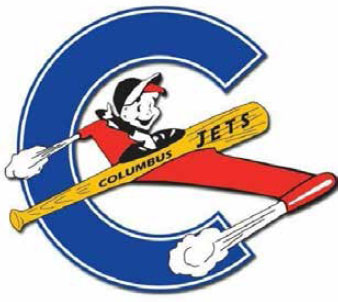The Columbus Jets: Takeoff for the Lumber Company
This article was written by Thomas Kern
This article was published in When Minor League Baseball Almost Went Bust: 1946-1963
Columbus Jets logo.
The state of Ohio has a rich baseball history. The city of Columbus has played a major role in that history, even though, unlike its sister cities Cincinnati and Cleveland, it has never hosted an American or National League team. It has been the home of an array of minor-league teams as well as several Negro League teams, namely the Buckeyes (1921), the Turfs (1932), the Blue Birds (1933), and the Elite Giants (1935).1 This story is about the Columbus Jets and their Pittsburgh Pirates connection as an International League Triple-A franchise from 1957 to 1970.
Minor-league baseball in Columbus dates from an independent team named the Buckeyes that joined as charter members of the International Association of Baseball in 1877. The Buckeyes were part of the expanding “major league” American Association in 1883, dropped out for a time, and then rejoined in 1889. The team was not included when the American Association merged with the National League in 1891 and for a time moved itinerantly between the minor-league-lev-el Inter-State and Western Leagues. In 1902 Columbus, under the name of the Senators, joined the inaugural season of a reformed American Association and was a continuous presence until 1954. The American Association of those days was an independent minor league, but as American and National League teams established farm systems, Columbus became a St. Louis Cardinals affiliate in 1931 and became the Redbirds.2
At the end of the 1954 season, the Cardinals opted to move their American Association entry to Omaha. The team won the Junior World Series in 1950, but otherwise had routinely finished in the second division and attendance suffered as a result. Fortunately for Columbus, “local business enthusiasts put up $10,000 each to re-establish pro ball in the city the following year. The Ottawa franchise of the International League was purchased [and relocated to Columbus] for $50,000.”3
The reconstituted franchise became known as the Jets, in honor of Columbus’s wartime role in the aviation industry.4 Curtiss-Wright Corporation, the largest US aircraft manufacturer, built a plant in Columbus in 1941 to build naval aircraft for the war in the Pacific. Its Curtiss SB2C Helldiver was a major contributor to the war effort.5
The Columbus Jets’ first parent club was the Kansas City Athletics for the 1955 and 1956 seasons. In 1957 the Pittsburgh Pirates established their Triple-A presence in Columbus, where they would remain for the next 14 years. Columbus and Pittsburgh are only 185 miles apart, making it relatively easy to move players back and forth as needed. The Jets’ early years were not promising, but in 1959, managed by Cal Ermer, the team finished second in the regular season to Buffalo, though it was swept by the eventual league champion Havana in the playoffs.6 Columbus won the regular season in 1961 under new manager Larry Shepard, and this time lost to Buffalo in the playoffs. Shepard helmed the team for six years before joining the Phillies as their pitching coach in 1967 and then managing the Pirates in 1968 and 1969.7 In Shepard’s next to last year at the helm, 1965, the Jets made it to the finals, but were defeated by Toronto, four games to one. This was the first of six successive playoff appearances for the Jets, through 1970, their final year in the International League.8
In 1965 the beginnings of the eventual Pirates roster for the late 1960s and 1970s began arriving in Columbus. Steve Blass had already surfaced, but Dock Ellis, Jerry May, José Pagân, and Luke Walker were now developing their skills at the Triple-A level. In 1966, when the Jets tied for second in the IL but lost to Toronto in the first round of the four-team playoffs,9 Manny Sanguillén appeared on the scene. Discovered by Herb Raybourn in Panama and then signed by him and Pirates superscout Howie Haak,10 Sanguillén started his play in Organized Baseball with the Batavia Pirates (New York-Penn League) in 1965. His potential was clear, and he spent time at both Raleigh (Carolina League) and Columbus in 1966. He played well overall, but in his brief time in Columbus hit only .231. (He batted .328 for Raleigh.) Sanguillén spent all or parts of the next two seasons in Columbus11 before being called up to Pittsburgh in 1969. Emerging prospects notwithstanding, the 1966 Jets were carried by their veterans; Gene Michael, 28 years old, George Spriggs, 29, and Dave Roberts, 33, provided the offense. They were aided by double-digit wins from Wilbur Wood, John Gelnar, Luke Walker, Jim Shellenback, and Ed Hobaugh to produce an 82-65 record.
The following year, 1967, after Shepard’s departure to the Phillies, Pete Peterson managed the team to fourth place and a sub-.500 regular-season finish. As the fourth-place team, they still made the playoffs and defeated Rochester before losing in the finals to Toledo, four games to one.12 That year, two new faces appeared, Bob Moose and Bob Robertson—key pieces for the Pirates of the coming years. The 19-year-old Moose went 4-1 with a 3.38 ERA. Fellow moundsman Dock Ellis, at the ripe old age of 22, was 5-7, leading the team in walks allowed, even though four other pitchers threw more innings. However, Ellis’s upside exceeded any concerns about his lack of control of the strike zone. Robertson showed the promise that would steer him to the majors. At the age of only 20, in 108 games he hit .256 with 14 doubles, 19 home runs, and 63 RBIs to go with an OPS of .810. At the end of the season, Peterson, more of a fill-in for Shepard than a long-term managerial solution, moved to the Pirates front office, where his subsequent career flourished, first as the team’s farm director, then as general manager.
Former Red Sox player and manager Johnny Pesky took over the team in 1968, having most recently served as Pirates manager Harry Walker’s first-base coach from 1965 to 1967. The 1968 season marked the arrival of Richie Hebner and Al Oliver, two more key pieces in the parent club’s future offense. The Jets finished second and made their fourth straight appearance in the IL playoffs, making it to the finals only to lose to Jacksonville, the New York Mets affiliate.13 Hebner (a first-round draft choice in 196614), at 20 managed 420 plate appearances and had a workmanlike year, batting .276 with 51 RBIs and a slugging percentage of .402. Oliver, a year older, did what he became known for in the majors: hit! He played in 132 games and had 149 hits, 14 home runs, and 74 RBIs. His batting average of .315 tied Manny Jiménez and Sanguillén had a breakout season, hitting .316. The future Lumber Company was beginning to come together.
The now revolving door of Columbus managers saw Don Hoak take over the reins in 1969. Hoak’s 11-year career in the majors was followed with a brief stint as a Pirates broadcaster and then as a manager in the Pittsburgh farm system. By the beginning of the season, Ellis, Moose, Walker, Hebner, Oliver, Robertson (who split time between Columbus and Pittsburgh), and Sanguillén were now in Pittsburgh. Dave Cash and Johnny Jeter were emerging, but the pipeline was beginning to dry up. The team finished fourth at 74-66 and made it to the playoff finals, which they lost to Syracuse, four games to one.15
Columbus’s final year as the Jets yielded one more postseason appearance. Under yet another new manager, Joe Morgan, the Jets compiled an 81-59 record, good enough for second place. Morgan, a journeyman in the majors, began coaching in the Pirates’ minor-league system in Columbus in 1966 and went on to manage the successor Charleston Charlies, with a one-year coaching stint with the Pirates in 1972 sandwiched in. He later managed the IL’s Pawtucket Red Sox and then the Boston Red Sox.
The Jets’ second-place finish in 1970 guaranteed a playoff spot, but after beating Rochester in a hard-fought first round, three games to two, they lost to Syracuse in the finals, three games to one.16 At this time, one more piece of the Lumber Company appeared, Rennie Stennett. Signed by Herb Raybourne, the Pirates’ talent scout in Panama, he was only briefly on the Jets roster. He gained further playing time in the minors with Charleston before making it to the Steel City.
Despite a run of six straight playoff appearances and five trips to the finals, the franchise struggled at the gate. An old ballpark and poor marketing both contributed to a 40 percent decline in attendance from its second highest of 197,680 in 1965 to a low of 140,700, its second worst as a franchise, in 1970. Columbus’s competitiveness in the mid-to late-l960s spoke to the promising talent in the Pittsburgh farm system that, once promoted, fueled the Pirates’ competitiveness and regular appearance in the National League playoffs in the early 1970s.17
Columbus never won the International League crown in any of the years as the Pirates’ Triple-A team. In its four trips to the finals—1965, 1967, 1968, and 1969—Toronto, Toledo, Jacksonville, and Syracuse bested Columbus, indicative of their own promising stars who would move to their parent teams (the Red Sox, Tigers, Mets, and Yankees respectively).
The Columbus-Pittsburgh tie was severed after the 1970 season. According to author O’Neal, “Although Columbus fielded consistent winners, attendance was disappointing, and spiraling costs triggered a franchise transfer to Charleston after the 1970 season.”18 The Pirates purchased the club from the Columbus Baseball Club, Inc. to move the team to West Virginia.
However, the Pittsburgh-Columbus connection was resurrected in 1977 when Harold Cooper, the long-standing general manager of the Jets, facilitated the move of the Memphis IL club to Columbus. Alas, this final connection lasted only one year before the franchise was moved again, this time to Portland in the Pacific Coast League.19 However, the reconstituted Clippers did not skip a beat. They were affiliated with the Yankees from 1979 to 2006, the Washington Nationals in 2007 and 2008, and the Cleveland Guardians (previously the Indians) ever since.
It might have been the Pirates’ iconic announcer Bob Prince who gave the offensive juggernaut that was the Pirates in the 1970s its name. The nascent Lumber Company (without being explicitly labeled so at the time) first surfaced in 1971, when Roberston, Hebner, Oliver, Sanguillen, and Stennett were fixtures. Willie Stargell, not quite yet the Pirates elder stateman (that moniker would be more appropriate in 1979 when Pittsburgh ended the decade with its second World Series win) was the veteran presence.
In August of 1971, Roy Blount wrote in Sports Illustrated, “The main difference between the Pirates who eked out a division title last year and the Pirates who are outmuscling all of baseball now is that not only are the line-drive hitters like Clemente, Cash, Sanguillen, Al Oliver and Clines still flourishing, but Stargell is heading toward 50-plus homers. Third Baseman Richie Hebner and First Baseman Bob Robertson (who reached Three Rivers’ left-field upper deck) have good shots at 30 and almost anyone in the lineup is a feasible threat to hit one out. Three Rivers’ fences are at nice, standard 340-, 385-and 410-foot distances.”20
In 1973 Dave Parker added his bat and glove to the team and was an obvious addition to the Lumber Company; the turn of phrase now became the norm for the team. The Pirates, better known for their hitting than pitching, nonetheless benefited from Doc Ellis, Bruce Kison, Bob Moose, Luke Walker, and John Lamb—all home-grown talent to go along with the pitchers they traded for to fill out their rotation and bullpen. Solid hitting and serviceable or better pitching made them a force to be reckoned with, and perhaps—if there had been no Big Red Machine— a multiple World Series winner in the mid-1970s to go with their trophies in 1971 and 1979.
Willie Stargell later wrote in his autobiography, co-authored with Tom Bird, “We were a confident, cocky group of hitters … who loved to bang the ball. We had built a name for ourselves as the Lumber Company. Posters featured Sangy [Sanguillén], Rennie Stennett, Richie Hebner, Scoop [Al Oliver], [Richie] Zisk,21 David [Parker], and me were printed and distributed everywhere in Pittsburgh. We loved our reputation. We wanted opposing pitchers to dread us.”22
There was no dearth of talent on the Jets teams of the late 1960s as evinced by the players named in this essay. But there were even more who made it to the majors, among them Bruce Dal Canton, Woodie Fryman, Gene Garber, José Martinez, Freddie Patek, Bob Priddy, and the aforementioned Gene Michael and George Spriggs. For many a Pirates fan, the Pittsburgh-Columbus connection is fondly remembered as the point of takeoff for the Lumber Company. It is the wish of any major-league club to have had such a good run of home-grown talent.
THOMAS KERN was born and raised in Southwest Pennsylvania. Listening to the mellifluous voices of Bob Prince and Jim Woods in his youth, how could he not become a lifelong Pirates fan? He now lives in Silver Spring, Maryland, and sees the Pirates, Nationals, and Orioles as often as possible. He is a SABR member dating back to the mid-1980s. With a love and appreciation for Negro League baseball in addition to the Pirates, he has written SABR bios for the 1979 Pirates and Clemente books and has completed bios for Leon Day, John Henry Lloyd, Willie Foster, Judy Johnson, Turkey Stearnes, Hilton Smith, Louis Santop, Andy Cooper, Double Duty Radcliffe, and others.
Acknowledgments
This article was edited by David Siegel and fact-checked by Mike Huber.
Sources
All statistical and biographical references are from Baseball-Reference.com, unless noted otherwise.
Notes
1 All but the Turfs (a short-lived appearance in the Negro Southern League) were in either of the two Negro National Leagues.
2 Bill O’Neal, The American Association: A Baseball History-1902-1991 (Austin, Texas: Eakin Press, 1991), 206-208.
3 O’Neal, 206-208.
4 Richard Worth, Baseball Team Names: A Worldwide Directory 1869-2011, (Jefferson, North Carolina: McFarland & Co, 2013), 82.
5 Columbus’s storied wartime aviation history is captured in part in these references: Table of U.S. Airplane Factories in WW2—Grumman, Curtiss-Wright, Bell, etc. (acepilots.com) and Curtiss-Wright Corporation, Airplane Division—Ohio History Connection Selections—(ohiomemory.org).
6 O’Neal, 408.
7 These details on Shepard and the careers of the Jets managers who followed him are from Baseball-Reference.
8 O’Neal, 409.
9 O’Neal, 409.
10 Bob Hurt, “Manny Sanguillen,” SABR Biography Project.
11 Sanguillen appeared in 30 games (with 23 starts) for the Pittsburgh Pirates in 1967, batting .271.
12 O’Neal, 409.
13 O’Neal, 409.
14 Allan Simpson, The Baseball Draft: The First 25 Years, 1965-1969 (Durham, North Carolina: American Sports Publishing, 1990), 32.
15 O’Neal, 409.
16 O’Neal, 409.
17 O’Neal, 264-267.
18 O’Neal, 265.
19 O’Neal, 265.
20 Roy Blount, “On the Lam with the Three Rivers Gang,” Sports Illustrated, August 2, 1971, found online at https://vault.si.com/vault/1971/08/02/on-the-lam-with-the-three-rivers-gang.
21 Zisk’s Triple-A stint was with Charleston a year after the Pirates moved from Columbus.
22 Willie Stargell and Tom Bird, Willie Stargell: An Autobiography (New York: Harper & Row, Publishers, 1984), 173. Fairly nor not, Bob Robertson did not officially figure in the Lumber Company lineup. He played for the Pirates until 1976, but suffered recurring knee problems, leading to operations on both. He did not play in 1977, was signed as a free agent by Seattle in 1978, and then played briefly for Toronto in 1979 before retiring from the game. Pirates fans will nonetheless remember him fondly for his contributions to the team’s World Series run in 1971 and for over 100 home runs in a Pittsburgh uniform.


